![[Metroactive Features]](/features/gifs/feat468.gif)
[ Features Index | Silicon Valley | Metroactive Home | Archives ]
Trippy Strips: The valley is rife with minimalls that defender Robert Venturi says aren't bad, just honest. Pictured here is Bel Gato Center.
It's a Mall World After All
More than the architecture of convenience, the strip mall is California epitomized
By Traci Vogel
DRIVING DOWN WEST SAN Carlos Street in San Jose is like cruising a drive-through timeline of strip malls. From the huge older complex that features such charmers as the Pineappl (sic) Laundrette and Larry's Theatrical Supply to the not-yet-completed but ambitious Santana Row, strip malls from every decade dot the landscape.
Many of the low-rise stores lined up side by side in the strip malls of San Carlos take the expansiveness of their surroundings literally, with names like Babyland, Copyland and LaunderLand filling in the geographical boundaries. I'm reminded of a classic Disney ride: It's a Strip Mall After All.
To most people, linear commercial development hardly evokes joy. The strip mall is the architectural equivalent of the leisure suit; urban planners and environmentalists revile it as impersonal, cookie-cutter, just plain butt-ugly; they damn the strip mall as the scourge of the suburbs. Patrons of multilevel enclosed malls look down on them.
Mall Land: Many local malls are owned by Italians who sold off their orchards but kept a parcel for themselves.
As far back as the 1950s, urban planners bemoaned the shoddy developments subdividing America's agricultural lands, and the fake qualities of roadside throw-ups with names like "Snak Shak, Tumble Inn, St. Bernard Dog Wagon, Machine Shoppe, and filling stations entitled 'Oil Well and All's Well' " (a sarcastic string put together by New York Parks Commissioner and urban megaplanner Robert Moses, writing in The Atlantic).
Opponents of car-based culture despise them. Neighborhood associations rally against them. Mayors apologize for them. There are whole libraries of anti-strip mall rhetoric out there, eloquent and impassioned stuff, religious in its intensity.
So, to paraphrase Robert Venturi, one of the authors of the 1977 city-planning classic Learning From Las Vegas: If it's so bad, why is it so inspiring?
Finding Beauty In Ugliness
According to Venturi, strip malls aren't bad--they're just honest. Most commercial ventures try to disguise their purpose a little, but the strip mall is utilitarian in the extreme. It fails in all categories of New Urbanism, the development philosophy that claims that traditional architectural elements--white picket fences, front porches, etc.--offer the secrets to a wholesome community.
On the surface, the strip mall possesses none of the nostalgic signifiers of New Urbanism. There seem to be no cozy gathering places. There are few decorative elements. The buildings do not cater to an idea of neighborhood--they completely thumb their noses at context.
But a certain landscape logic informs the strip mall. In a culture that, for better or for worse, is heavily car-reliant, the strip mall makes sense. While downtowns across the country were closing off their streets to cars--and thus to retail business, often--strip malls added parking spots. Driving past a strip mall is sometimes like paging through a giant catalog: brand names and services are painted in 5-foot-high lettering; symbols float above flat rooftops. The signage may not always be attractive, but it certainly makes shopping from the freeway more straightforward.
Which brings us back to Learning From Las Vegas. Architecture, Venturi said, is all about signs. Venturi broke buildings down into two broad categories, which he named "sheds" and "ducks." A shed is just what it sounds like: a very basic blocklike form that serves no aesthetic function other than to stand as a base for a sign--what Venturi called "the $10,000 building with the $100,000 sign."
The "duck," on the other hand, is a building that itself is a sign. Venturi named the category after a Long Island roadside attraction shaped like a duck, a building that advertised itself. San Jose's Tech Museum is a duck. The Knight-Ridder building ... well, it's hard to tell. It sure looks like a shed, but if it's meant to symbolize its product, it may well be a duck.
The strip mall is technically a shed. But although most strip malls, especially the variety built in the '60s and '70s, seem designed to look like nonplaces, like incredibly bland, anonymous commercial catch-alls, they have in spite of themselves become very real places indeed: destinations, neighborhood entities--even, sometimes, functioning as traditional downtowns ideally should.
As a result, the strip mall is far from the enemy of community. In many cases, in fact, the neighborhood strip mall is the last bastion of the small-business owner who cannot afford downtown rent (which is driven up by land value and by the cost of parking spaces), much less a spot in Valley Fair.
The strip mall, especially in Silicon Valley, has become by default the refuge of beauty salons, comic-book stores, ethnic restaurants, family dentists, pizzerias and record shops. It is the place most likely to host a birthday party or to service last-minute Christmas shopping. The strip mall is home.
Marquee Mark: San Jose's South Bascom is a shop-and-go-paradise of strip malls from the 1960s.
California Design
The historical origins of strip mall design are obscured in the promotional pamphlets of time. Some say the first strip mall opened in Kansas City, Mo., in 1922. Others insist the idea harkens back to the Paris arcades of the mid-19th century.
There is even a persistent rumor that the grandfather of actor Ed Norton, urban planner and developer James Rouse, was the real inventor--but while Mr. Rouse may have done much to modernize the strip mall's design and ensure its popularity in the state of Florida, there is no evidence that we should enshrine his name in strip mall posterity.
Wherever it originated, the humble strip mall has come to seem a quintessentially California idea, and it is in this state's suburban areas that it has found its true environment. At least one new mall is built a year in California, mostly to serve as supply points essential in the untapped wastelands of residential developments like Silver Creek, which sprawl into empty foothills naturally devoid of the guiding light of a Blockbuster Video.
The strip mall is so inherent to the idea of California suburbia that its original floor plan, the basic Main Street/sidewalk layout, has come to be known as the "California" design. And while business in enclosed malls is on the decline, strip mall-type construction is enjoying a nationwide resurgence. Riding the wave, you may have noticed, is a partnership between Noah's Bagels, Starbucks, and Jamba Juice--corporations that have taken advantage of their appetizing symbiosis by taking up tenantship next to one another in specially built strip malls nationwide.
But it's in the older strip malls, locally, that the real treasures can be found. Like Space Cat collectibles, comics and cards, on South Bascom in San Jose. Or the Cardinal Lounge on Meridian Avenue in San Jose, where you can take the kids to dinner in the restaurant or drown your sorrows in the adjoining lounge. These places offer the thrill of discovery in the strip mall jungle.
Real Places
The intersection of Meridian and Hamilton, on San Jose's west side, reveals a cityscape of strip malls--all, judging from appearances, built between the 1950s and the 1990s.
Here, couched beneath low-slung acoustical tiles, one can get shoes repaired, have keys made, shop at Vietnamese bakeries, drop off dry cleaning, buy insurance. Down the block a little, a newer mall with an awkwardly articulated facade showcases the omnipresent strip mall video chain, Blockbuster.
The aging rose of the bunch is the Carriage Square Shopping Center, with its '60s-era sign evoking the glamour of a far earlier age, when shopping, if it even existed as a cross-class concept, consisted of an arduous trip to Paris for the new spring lines.
Today, Carriage Square sports the Three Flames Restaurant and Lounge, Straw Hat Pizza, Merle Norman and the Starving Musician, and serves as a perhaps unintentional example of the vitality that comes from a mix of commercial tenants.
Missouri Loves Company: Some say the design for strip malls such as Maplewood Plaza originated in Missouri in the 1920s.
Three Flames Restaurant and Lounge, which has been housed in Carriage Square since 1980, is a self-nourishing habitat itself, the hangout of horse bettors and families alike, with the kind of plush bar seating that bodes well for long conversational afternoons. The Flames of the restaurant's name are three Greek brothers, and the club hosts Rotary Club meetings on a regular basis. (If the Rotary Club is not your thing, there's a Moose Lodge just down Meridian.)
A few doors away, the Starving Musician's second South Bay location has found a niche--and a unique form of advertising. The store's trademark giant manic heads poster the windows, above which the shop's many specialties--guitars, amps, drums, band instruments among them--are boldly noted. Venturi would be proud.
Generally, though, signage in a strip mall is a hit-and-miss affair. Since business turnover can be high, many stores opt for temporary banners, which fade and droop and add to the ramshackle quality of the mall; or they paint the large-scale windows with advertisements that then become scratched canvases displaying the philosophical outpourings of bored customers.
Across town--and across social classes--sits the brand-new Canyon Creek Plaza, at Yerba Buena and Valley Road. Built in the fuzzy country club grasslands of Silver Creek, Canyon Creek is painted in the nouveau riche coloring box of taupe, sage and dusty mauve. The complex gleams with the stucco subtlety of Los Angeles. Here, the tired Lexus owner can rent Rush Hour 2, dash in for a day spa at Moda Salon or sidle up to a white-clothed table and enjoy a four-star Caesar salad from Spivac's--all without having to repark the car.
Dick's Center
Canyon Creek also features a Cosentino's grocery store. Cosentino's, a 54-year-old local grocery chain owned by four brothers, exemplifies what retired San Jose State University art professor and valley folklorist John De Vincenzi describes as the Italian retail vanguard.
In fact, De Vincenzi lays claim to an interesting tidbit. Almost all the strip malls in the valley are, or were originally, owned by Italians, for one simple, historical reason: When Italian immigrant farmers in San Jose sold their land off to housing developers in the various sprawl booms of the '50s, '60s and '70s, many times they kept one little plot of land amid the housing for a strip mall. Talk about foresight.
De Vincenzi, who is in the process of researching a book to be titled Something Italian: The History of Italians in Santa Clara County, says, "If my research is correct, it looks like about 75 percent of your small-to-medium shopping centers in the county are owned by Italians. ... The number may end up being even higher than that."
Carriage Square
Obviously, despite the odds, many strip malls carry with them a truly evocative sense of history. And that history can be every bit as real and important as the history of buildings we traditionally think of as monuments.
These days, the Vietnamese strip mall is a growing phenomenon in Silicon Valley, which makes sense. According to the Census Bureau, the number of Asian Americans grew to 11 percent of California's population in 2001, largely due to high rates of immigration, and these immigrants have brought with them their own ready-made culture.
All they need is someplace to house it. Many blocks of strip malls appear to be their own Asian islands. Spend an afternoon at the East Side's Asian Plaza, for example, and you may go hours without hearing a word of English.
Asian Plaza
From the parking lot, the Asian Plaza looks like a giant child's-block model of classical architecture: massive columns flank the entryways; a fountain with frolicking dolphins tinkles. But the place is bustling with businesses: TK Noodle, First Choice Family Dental, a tea shop, a laundry, a hair and nails place, a supermarket, a baker, a Pho restaurant, a low-income clinic, insurance and travel stores.
The waves of immigration that Silicon Valley has embraced are reflected in the changeable nature of the strip mall's architecture. Oftentimes, the strip mall functions like a picture frame, ready to feature whatever face slips into its glass auspices next.
For this reason, the low-rent strip mall is really the architecture of efficiency, of the free market defined. These are monuments to urgency, and they were never meant to last forever. This transience is the real face of Silicon Valley.
Photograph by Dan Pulcrano
Strip Mall Love
One of the problems with New Urbanism is that it assumes a snobby connection between a middle-class aesthetic and a higher quality of life. For years, there has been an undeniable parallel between social class and shopping outlets. In short, the wealthier you were, the cuter your hair salon was likely to be--and the less likely to be in a strip mall.
The triumph of the strip mall, then, is really the triumph of egalitarian architecture. We are all customers in the same crowded parking lot, getting our hair cut together, comrades in cement.
Stan's Scuba
I got my first real kiss in a strip mall, one built on the farmland expanse of my childhood in Washington State. This strip mall had been built in the mid-'70s, and by the time I shopped there, it was seriously outdated. The courtyard was aggregate; the wood paneling dark. The anchor store was something called "The Bay," a Canadian import that sold basics, pre-GAP.
And I loved everything about it. For me, a trip to the strip mall meant new shoes. It meant greasy fish 'n' chips. It meant gawking at that swinging relic of a store, the T-Shirt Stop, which displayed punning sexual innuendoes on cotton of all sizes. It meant culture, in the sense that culture is connection with other people.
One Sunday afternoon, when I was in seventh grade, some nice mothers got the mall to shut down its courtyard, and decorated it as a dance floor. I do not remember the music. I don't even remember anyone dancing, really. All I remember is the boy--a stranger--and me, sitting against the outside wall of The Bay, turning to one another and silently agreeing to make out.
I can still feel my palm, digging into the dusty aggregate, while the rest of me floated away like cotton candy toward the advertisements in the sky.
[ San Jose | Metroactive Central | Archives ]
Copyright © Metro Publishing Inc. Metroactive is affiliated with the Boulevards Network.
For more information about the San Jose/Silicon Valley area, visit sanjose.com.
![]()
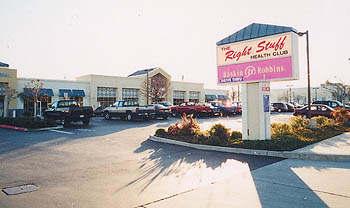
Photograph by Max Knies
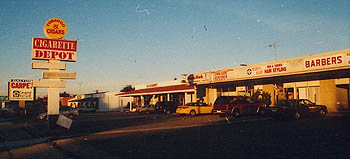
Photograph by Max Knies
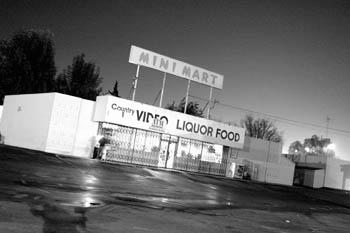
Photograph by Jeff Kearns
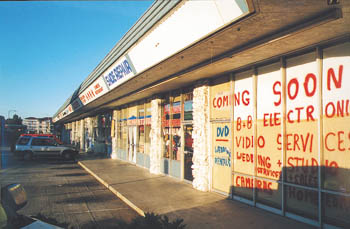
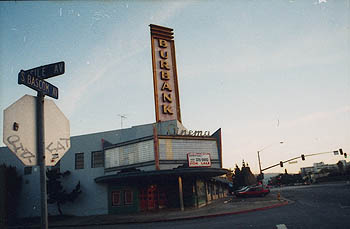
Photograph by Max Knies
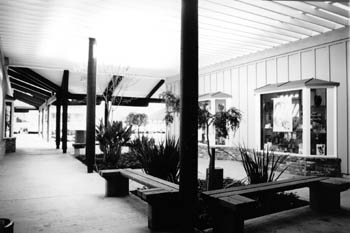
Photograph by Max Knies
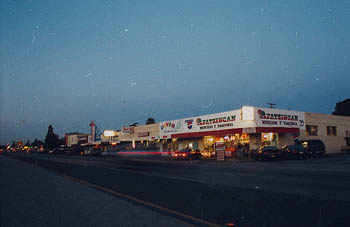
Photograph by Max Knies
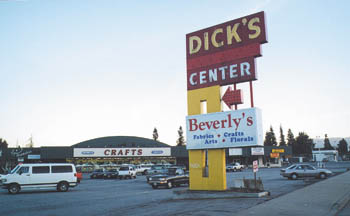
Photograph by Max Knies
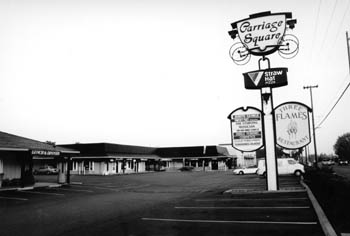
Photograph by Max Knies
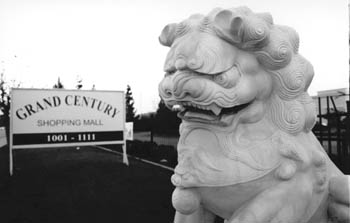
Photograph by Max Knies
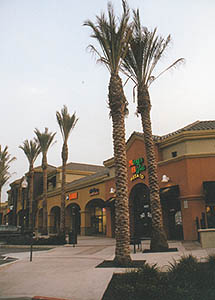 Suburban Safari: Silver Creek's Canyon Creek Plaza, with parking wide enough for an SUV.
Suburban Safari: Silver Creek's Canyon Creek Plaza, with parking wide enough for an SUV.
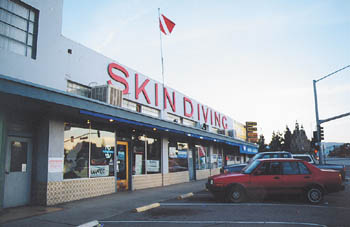
Photograph by Max Knies
From the January 24-30, 2002 issue of Metro, Silicon Valley's Weekly Newspaper.